Guest Blog by Diane Gottlieb
![]()
Hello, All. My friend, Diane Gottlieb, is an expert blogger. She writes the blog WomanPause.
WomanPause is about life after 50, and Diane explores everything from invisibility to the she-ro. With her background in creative nonfiction, Diane is a consummate interviewer, and she makes the most of her guests’ unique perceptions about life. I’m honored that she has agreed to guest blog this week. Her take on COVID-19’s TP crisis is both humorous and thorough. I encourage you to visit/subscribe to her blog, which is published every other Monday. Thanks, Diane!
BIO:
Diane Gottlieb received an MFA from Antioch University Los Angeles where she served as lead editor of creative nonfiction and as a member of the interview and blog teams for Lunch Ticket. Her work has appeared in Hippocampus Magazine, Brevity’s Nonfiction Blog, McSweeney’s, Entropy, Burningword Literary Journal, Panoply, and Lunch Ticket. You can also find her bi-monthly musings at https://dianegottlieb.com.
Do We Have Enough Toilet Paper Yet?
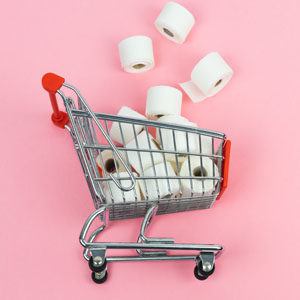 Toilet paper. Toilet paper. Toilet paper. It seemed for a while that the nation’s worry about the availability of TP ranked just below the concern for the ill, the death tolls, and the economy.
Toilet paper. Toilet paper. Toilet paper. It seemed for a while that the nation’s worry about the availability of TP ranked just below the concern for the ill, the death tolls, and the economy.
One of the unforeseen fallouts of the COVID19 pandemic has been the run (excuse the pun) on toilet paper. The scramble for the new “white gold” can be described as nothing less than extreme: In a Dollar General store in Iowa recently, a man was waiting for the cashier to ring up his purchase of toilet paper when another man behind him commented on the number of rolls he was buying. The first shopper felt “threatened” and pulled out a gun. (The police came before anyone was injured and the man without the gun was arrested!)
Toilet Paper Panic Is Not Strictly An American Phenomenon
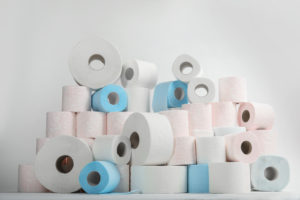 I’ve heard several stories like this one taking place across the country, but the toilet paper craze is not unique to the U.S. Several armed individuals in Hong Kong stole 600 rolls from a supermarket. One store in Sydney, Australia decided it needed to hire a security guard to watch over its toilet paper aisle.
I’ve heard several stories like this one taking place across the country, but the toilet paper craze is not unique to the U.S. Several armed individuals in Hong Kong stole 600 rolls from a supermarket. One store in Sydney, Australia decided it needed to hire a security guard to watch over its toilet paper aisle.
(Aussies seem to have a good sense of humor about the whole phenomenon. One Australian newspaper included eight blank pages in an addition as a remedy for when its readers “run out of loo paper.” Aussies are also resourceful. One café started accepting toilet paper as currency—three rolls in exchange for a cup of joe.)
While I believe the numbers of fist fights over the remaining jumbo 48-roll packs in COSTCO have decreased in our country, the lack of TP accessibility—and the hoarding—is still “a thing.”
What Is Going On?!?
 The phenomenon has been the fodder for some good jokes and has given more than a few of us some lighter moments during the current tragedy. But toilet paper? Really? Of all the things to hoard, toilet paper seems a strange one. The dire need many people feel to procure those extra sheets of Charmin has been a puzzle I’ve had trouble wrapping my head around. What is this toilet paper craze all about?
The phenomenon has been the fodder for some good jokes and has given more than a few of us some lighter moments during the current tragedy. But toilet paper? Really? Of all the things to hoard, toilet paper seems a strange one. The dire need many people feel to procure those extra sheets of Charmin has been a puzzle I’ve had trouble wrapping my head around. What is this toilet paper craze all about?
There has been, surprisingly, quite a bit written about the phenomenon, and to alleviate my curiosity (and to kill some time) I researched the topic—for hours! Here’s what I got!
According to the LA Times , most Americans use an average of less than half a roll each week—give or take. Even if we use a slightly higher number, “it would take a household of 15 to rip through just one Costco-sized 30-pack of Kirkland Signature two-ply over the course of a 14-day quarantine. For a couple, one pack should last for nearly four months.”
Four months!
The Practical And The Psychological—Two Explanations
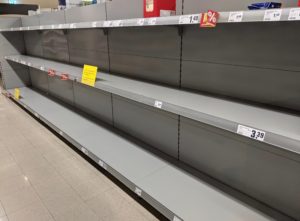 Under normal circumstances, there is no problem keeping up with the demand for toilet paper. But there is nothing normal about life under coronavirus and the current toilet paper demand. Fully stocked shelves become empty as soon as supermarkets open their doors. People must be running out of storage space for TP in their homes by now.
Under normal circumstances, there is no problem keeping up with the demand for toilet paper. But there is nothing normal about life under coronavirus and the current toilet paper demand. Fully stocked shelves become empty as soon as supermarkets open their doors. People must be running out of storage space for TP in their homes by now.
Yet, demand continues, and this continuing demand reflects several factors—some practical, involving economics and supply and demand principles. The other factors are more psychological in nature, involving the opposite end of our bodies—our brains.
Let’s Hit The Practical First
The shortage of available toilet paper is partially due to TP’s normal demand cycle, which is pretty reliable with few fluctuations.
Scott Luton, the CEO and founder of Supply Chain Now explains in USA Today: “The supply chain for toilet paper is not built for dramatic shifts and seasonal demand changes. It’s not like pumpkins during the fall and chicken wings during the Super Bowl.”

Corporations that produce toilet paper, therefore, are not prepared for such sudden upticks in demand. They don’t have the infrastructure. (The big producers are now pumping out rolls 24/7, so help is on the way!
During natural disasters, or even when The Weather Channel predicts a storm, consumers living in those specific geographical areas do exhibit “stocking-up” behaviors. But our current crisis is a global one. Excess supply from one region cannot be diverted to another. There is no excess supply—anywhere!
The Lack Of Availability Is Not Solely Due To Hoarding
Because of COVID19, most of us are spending a great more time at home—which means we’re also using our home bathrooms much more than when we went to the office, to school, or frequented restaurants.
 People actually doneed to purchase more toilet paper than under pre-COVID conditions. According to USA Today, we’re experiencing an “estimated 40% increase over the average daily home usage.”
People actually doneed to purchase more toilet paper than under pre-COVID conditions. According to USA Today, we’re experiencing an “estimated 40% increase over the average daily home usage.”
Unfortunately, we can’t easily move the lonely unused rolls of toilet paper sitting in public bathrooms, over to private spaces. “Office” toilet paper is a very different product!
How different can it be, you ask? Again, USA Today has the answer: “One kind of bath tissue—for the commercial market—often is made of one ply of recycled fiber and generally is found on rollers at businesses and public places. The other kind—retail toilet paper—is often made of two-ply virgin fiber and is generally much softer for use at home.”
Has anyone else noticed that TP is softer at home?
Hoarding 101
Ok. So we now have a better understanding of the economics and logistics of the craze. Let’s look next at the psychology behind it all. We’ll start with the easy stuff, general reasons for hoarding.
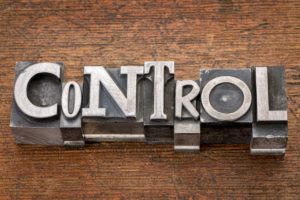 Much of the TP panic can be summed up in one word: control.
Much of the TP panic can be summed up in one word: control.
Deborah Small, a psychologist at Wharton, explains in the Philadelphia Inquirer: “We all have this fundamental motive to maintain control over our environments … when we go about our daily lives, most of the time we feel pretty in control, right? We have freewill. Most people can purchase things that they need when they want to … when something extraordinary happens like this, then we feel out of control, and purchasing and having lots of stuff around us is one way that we can feel in control.”
The need to control (and to express that need in such bizarre-o ways) is felt most intensely during uncertain times and when we are presented with unclear or mixed messages. In other words, times when there is little we can do to control and what the little we can do is unclear. In still other words, when we have very little objective control. I would say our current COVID environment fits those criteria. Add to that the fact that we don’t know when this damn thing is going to end, and we have the perfect recipe for hoarding.
Hoarding Provides People With A Sense Of Control
According to Dr Bella DePaulo , “people are worried, and they want to do something … and stocking up on toilet paper is one option. Research on decision-making has documented a ‘zero risk bias.’ People like the idea of eliminating one category of risk entirely, even if it is something as superficial as running out of toilet paper. People can get complete control over that one little thing in their lives.”
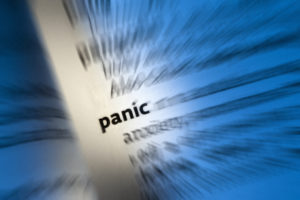 FOMO, or the Fear of Missing Out is one of the “11 Psychological Reasons Why We Hoard Toilet Paper in a Crisis” presented in an article in Inverse. FOMO is sparked in large part by news clips and social media. Sylvain Senecal, professor of marketing at HEC Montreal University, explains: “if media reports that people are stocking up on toilet paper, (others) will be motivated to do the same even if they cannot objectively explain why they do so. It’s the “scarcity effect.”
FOMO, or the Fear of Missing Out is one of the “11 Psychological Reasons Why We Hoard Toilet Paper in a Crisis” presented in an article in Inverse. FOMO is sparked in large part by news clips and social media. Sylvain Senecal, professor of marketing at HEC Montreal University, explains: “if media reports that people are stocking up on toilet paper, (others) will be motivated to do the same even if they cannot objectively explain why they do so. It’s the “scarcity effect.”
Let’s face it—scarcity consciousness is an unfortunate but powerful motivator .
We can behave like herd animals, especially when we’re scared. According to Dr. Small, “There’s general panic, and then there’s panic over other people’s panic.” It becomes a self-fulfilling prophecy.
But WHY Toilet Paper?
 Some psychologists, like Small, don’t think there is anything inherent in toilet that makes it a particularly unique target of hoarding. Ronald Mackerville, Professor of Recreation and leisure studies at University of Waterloo agrees and believes “If social media had focused instead on images of lines at gas stations, or empty shelves of canned goods, we might have seen very different behavior.”
Some psychologists, like Small, don’t think there is anything inherent in toilet that makes it a particularly unique target of hoarding. Ronald Mackerville, Professor of Recreation and leisure studies at University of Waterloo agrees and believes “If social media had focused instead on images of lines at gas stations, or empty shelves of canned goods, we might have seen very different behavior.”
But the fact remains that social media didn’t focus on other images; it focused on TP! Why?
DePaulo finds that toilet paper “has some particularly attractive qualities as an object of hoarding.” Here are several of the qualities DePaulo offers on her list:
- “Toilet paper isn’t perishable. It will be there for you when you need it, and no matter how long that takes, you will eventually need it.
- You aren’t really wasting your money. It is relatively inexpensive, too.
- And because it is a product that takes up so much space, you probably don’t have a lot of it stocked up already.
- In a pinch, toilet paper can be used as a substitute for tissues.”
Dr. Baruch Fischhoff, professor in the Department of Engineering and Public Policy at Carnegie Mellon University, highlights another very logical reason in Time . “If people did not find the food they wanted, they could buy other food. For toilet paper, there are no substitutes.”
How true? Unless you are seriously fond of showers or have a bidet, without TP, you are up a creek.
(Two additional comments to add here. Bidet sales have, in fact, surged recently, according to the Washington Post . On a more personal level, I have just started watching the Netflix series Schitt’s Creek. Could it be related???)
Let’s Get Down And Dirty
Ok. Here’s where we get down and dirty—literally. There’s a more “primitive,” unconscious reason that so many of us have sought out toilet paper.
 Freud anyone?
Freud anyone?
Leave it to the New Yorker to publish an article called “What would Freud Make of the Toilet-Paper Panic.” In his piece Henry Alford asks Andrea Greenman, president of the Contemporary Freudian Society her take on the toilet paper panic: “‘Controlling cleanliness around B.M.s is the earliest way the child asserts control. The fact that now we are all presumably losing control creates a regressive push to a very early time. So, I guess that translates to the unconscious to ‘If I have a lifelong supply of toilet paper, I’ll never be out of control, never be a helpless, dirty child again.’”
Oh boy!
Jeffrey Kluger in his article for Time also goes way back to explain our connection to the paper product: “Toilet paper has primal—even infantile—associations, connected with what is arguably the body’s least agreeable function in a way we’ve been taught from toddlerhood.” When he asked Mary Alvord, associate professor of psychiatry and behavioral sciences at GW, to share her thoughts, she said, “We’ve gone beyond using leaves, its’ about being clean and presentable and social and not smelling bad.”
When you put it that way …
Dr. DePaulo makes this special connection between toilet paper and COVID: “Messaging around the coronavirus is all about hygiene and cleanliness: wash your hands don’t touch your face, don’t’ get too close to other people and their germs. Toilet paper is about hygiene and cleanliness, too, in ways people are a bit more reluctant to discuss. No need to talk about it,” she adds, “just fill your shopping cart …”
A Different Take On Control
So … now you know more about the connection between toilet paper and COVID than you ever dreamed possible. I hope this post has not only enlightened you with critical information but has lightened any heaviness you may be carrying about the surreal state of being we are all trying to manage.

By all means, buy toilet paper when you can find it, but remember, hoarding is based in fear. And fear can make us close up, become smaller, and think little of those outside our own inner circle.
The toilet paper crisis, like much else in our society, hurts the neediest the most. Hoarding and resulting product unavailability can lead to higher pricing, which makes even buying a small number of rolls more challenging for those who have little to spare.
Choosing not to hoard TP can actually be one small way to access feelings of greater control in an uncertain time—by overcoming the fear of scarcity and leaving a few rolls our neighbors.
As Always, I’d Love To Hear Your Thoughts! Leave A Comment Or Send Me An Email!
Be Safe. Be Healthy. Be Brave.
See You In Two Weeks!
Diane

____________________________________________
I welcome your comments: gretaholtwriter.com/blog.
{Thank you to my niece, Addie (Liechty) Kogan, for taking the picture that is this blog’s featured image. Her blog is: https://addieswriting.wordpress.com.}
Best wishes and have a good week.
Greta